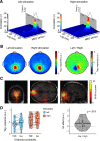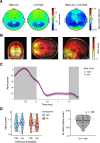Statistical Learning of Distractor Suppression Downregulates Prestimulus Neural Excitability in Early Visual Cortex
- PMID: 36801825
- PMCID: PMC10039740
- DOI: 10.1523/JNEUROSCI.1703-22.2022
Statistical Learning of Distractor Suppression Downregulates Prestimulus Neural Excitability in Early Visual Cortex
Abstract
Visual attention is highly influenced by past experiences. Recent behavioral research has shown that expectations about the spatial location of distractors within a search array are implicitly learned, with expected distractors becoming less interfering. Little is known about the neural mechanism supporting this form of statistical learning. Here, we used magnetoencephalography (MEG) to measure human brain activity to test whether proactive mechanisms are involved in the statistical learning of distractor locations. Specifically, we used a new technique called rapid invisible frequency tagging (RIFT) to assess neural excitability in early visual cortex during statistical learning of distractor suppression while concurrently investigating the modulation of posterior alpha band activity (8-12 Hz). Male and female human participants performed a visual search task in which a target was occasionally presented alongside a color-singleton distractor. Unbeknown to the participants, the distracting stimuli were presented with different probabilities across the two hemifields. RIFT analysis showed that early visual cortex exhibited reduced neural excitability in the prestimulus interval at retinotopic locations associated with higher distractor probabilities. In contrast, we did not find any evidence of expectation-driven distractor suppression in alpha band activity. These findings indicate that proactive mechanisms of attention are involved in predictive distractor suppression and that these mechanisms are associated with altered neural excitability in early visual cortex. Moreover, our findings indicate that RIFT and alpha band activity might subtend different and possibly independent attentional mechanisms.SIGNIFICANCE STATEMENT What we experienced in the past affects how we perceive the external world in the future. For example, an annoying flashing light might be better ignored if we know in advance where it usually appears. This ability of extracting regularities from the environment is called statistical learning. In this study, we explore the neuronal mechanisms allowing the attentional system to overlook items that are unequivocally distracting based on their spatial distribution. By recording brain activity using MEG while probing neural excitability with a novel technique called RIFT, we show that the neuronal excitability in early visual cortex is reduced in advance of stimulus presentation for locations where distracting items are more likely to occur.
Keywords: alpha rhythm; distractor suppression; frequency tagging; magnetoencephalography; statistical learning; visual attention.
Copyright © 2023 the authors.
Figures





Similar articles
-
Proactive distractor suppression in early visual cortex.Elife. 2025 Mar 17;13:RP101733. doi: 10.7554/eLife.101733. Elife. 2025. PMID: 40095805 Free PMC article.
-
Learning What Is Irrelevant or Relevant: Expectations Facilitate Distractor Inhibition and Target Facilitation through Distinct Neural Mechanisms.J Neurosci. 2019 Aug 28;39(35):6953-6967. doi: 10.1523/JNEUROSCI.0593-19.2019. Epub 2019 Jul 3. J Neurosci. 2019. PMID: 31270162 Free PMC article.
-
Guided visual search is associated with target boosting and distractor suppression in early visual cortex.Commun Biol. 2025 Jun 11;8(1):912. doi: 10.1038/s42003-025-08321-3. Commun Biol. 2025. PMID: 40500285 Free PMC article.
-
History Modulates Early Sensory Processing of Salient Distractors.J Neurosci. 2021 Sep 22;41(38):8007-8022. doi: 10.1523/JNEUROSCI.3099-20.2021. Epub 2021 Jul 30. J Neurosci. 2021. PMID: 34330776 Free PMC article.
-
Statistical Learning of Frequent Distractor Locations in Visual Search Involves Regional Signal Suppression in Early Visual Cortex.Cereb Cortex. 2022 Jun 16;32(13):2729-2744. doi: 10.1093/cercor/bhab377. Cereb Cortex. 2022. PMID: 34727169
Cited by
-
The multidimensional relationship between alpha oscillations and cognition.Imaging Neurosci (Camb). 2025 Aug 4;3:IMAG.a.96. doi: 10.1162/IMAG.a.96. eCollection 2025. Imaging Neurosci (Camb). 2025. PMID: 40800922 Free PMC article.
-
Spatial transfer of object-based statistical learning.Atten Percept Psychophys. 2024 Apr;86(3):768-775. doi: 10.3758/s13414-024-02852-3. Epub 2024 Feb 5. Atten Percept Psychophys. 2024. PMID: 38316722 Free PMC article.
-
Learning Modulates Early Encephalographic Responses to Distracting Stimuli: A Combined SSVEP and ERP Study.J Neurosci. 2025 May 21;45(21):e1973242025. doi: 10.1523/JNEUROSCI.1973-24.2025. J Neurosci. 2025. PMID: 40185634 Free PMC article.
-
Category-like representation of statistical regularities allows for stable distractor suppression.Front Psychol. 2025 Aug 6;16:1598594. doi: 10.3389/fpsyg.2025.1598594. eCollection 2025. Front Psychol. 2025. PMID: 40842602 Free PMC article.
-
Pre-stimulus activities affect subsequent visual processing: Empirical evidence and potential neural mechanisms.Brain Behav. 2025 Feb;15(2):e3654. doi: 10.1002/brb3.3654. Brain Behav. 2025. PMID: 39907172 Free PMC article. Review.
References
-
- Anstis S, Cavanagh P (1983) A minimum motion technique for judging equiluminance. Toronto: York University.
Publication types
MeSH terms
Grants and funding
LinkOut - more resources
Full Text Sources
Miscellaneous
